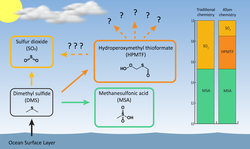New chemical discovered during ATom-3 to spur reexamination of marine sulfur cycle and climate models
The discovery of a novel sulfur compound during a 2017 NASA airborne research campaign will likely spur a scientific reassessment of a fundamental marine chemical cycle which drives the formation of oceanic clouds that play a key role in moderating climate, scientists said. The chemical, dubbed hydroperoxymethyl thioformate (or HPMTF), was discovered by NOAA scientist Patrick Veres while monitoring air samples being analyzed by a new NOAA Chemical Ionization Mass Spectrometer on board NASA’s instrumented DC-8 flying laboratory. The discovery was made on the third of four legs of the NASA Atmospheric Tomography campaign, known as ATom for short, in September 2017. Observations on the final leg in May 2018 confirmed the finding.
The research is published in a recent PNAS paper: "Global airborne sampling reveals a previously unobserved dimethyl sulfide oxidation mechanism in the marine atmosphere", by Patrick Veres. ACOM co-authors are Simone Tilmes, Douglas Kinnison, Rebecca Hornbrook, Alan Hills, and Eric Apel.
Read more at NOAA Research News . . .
